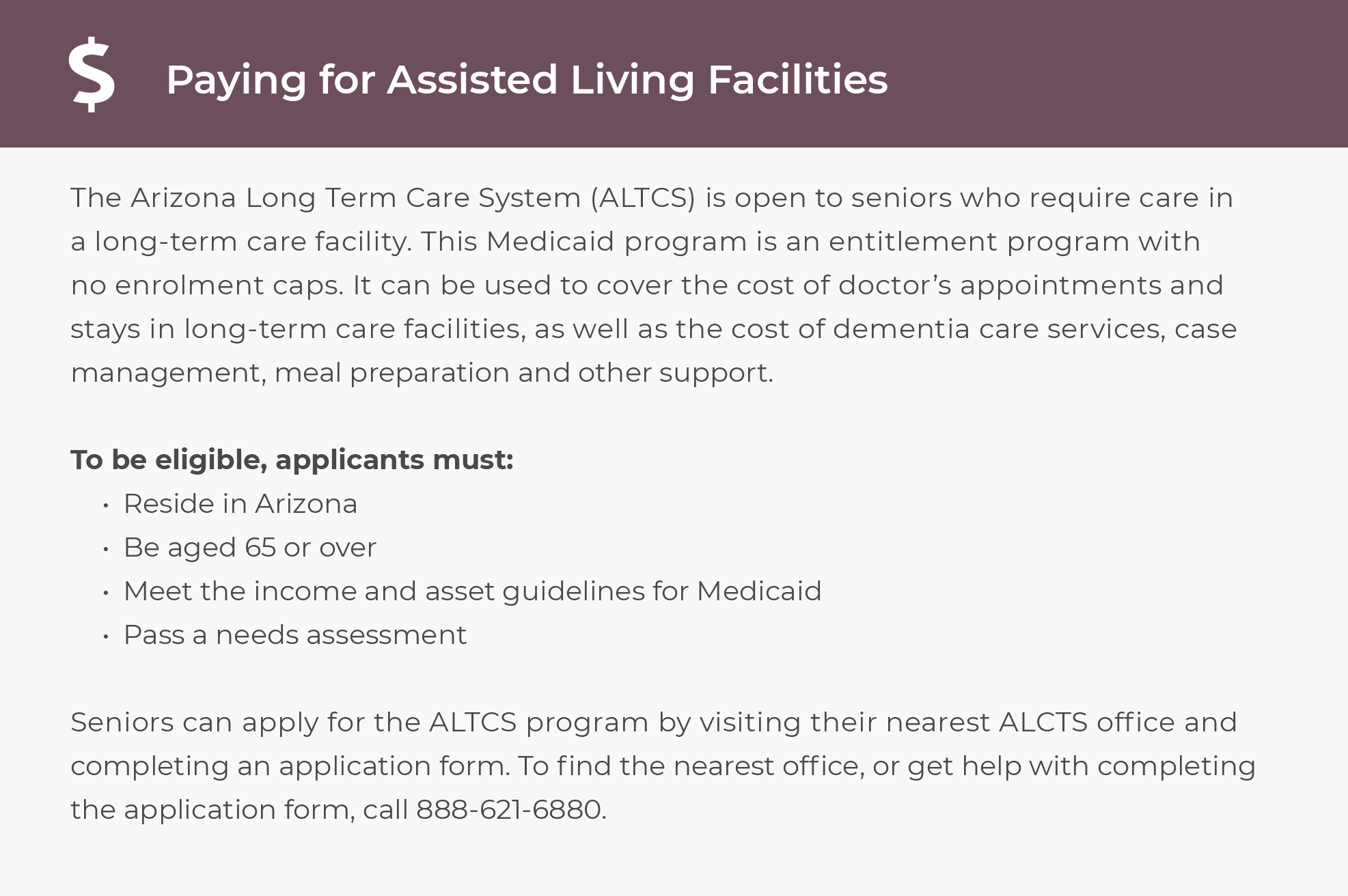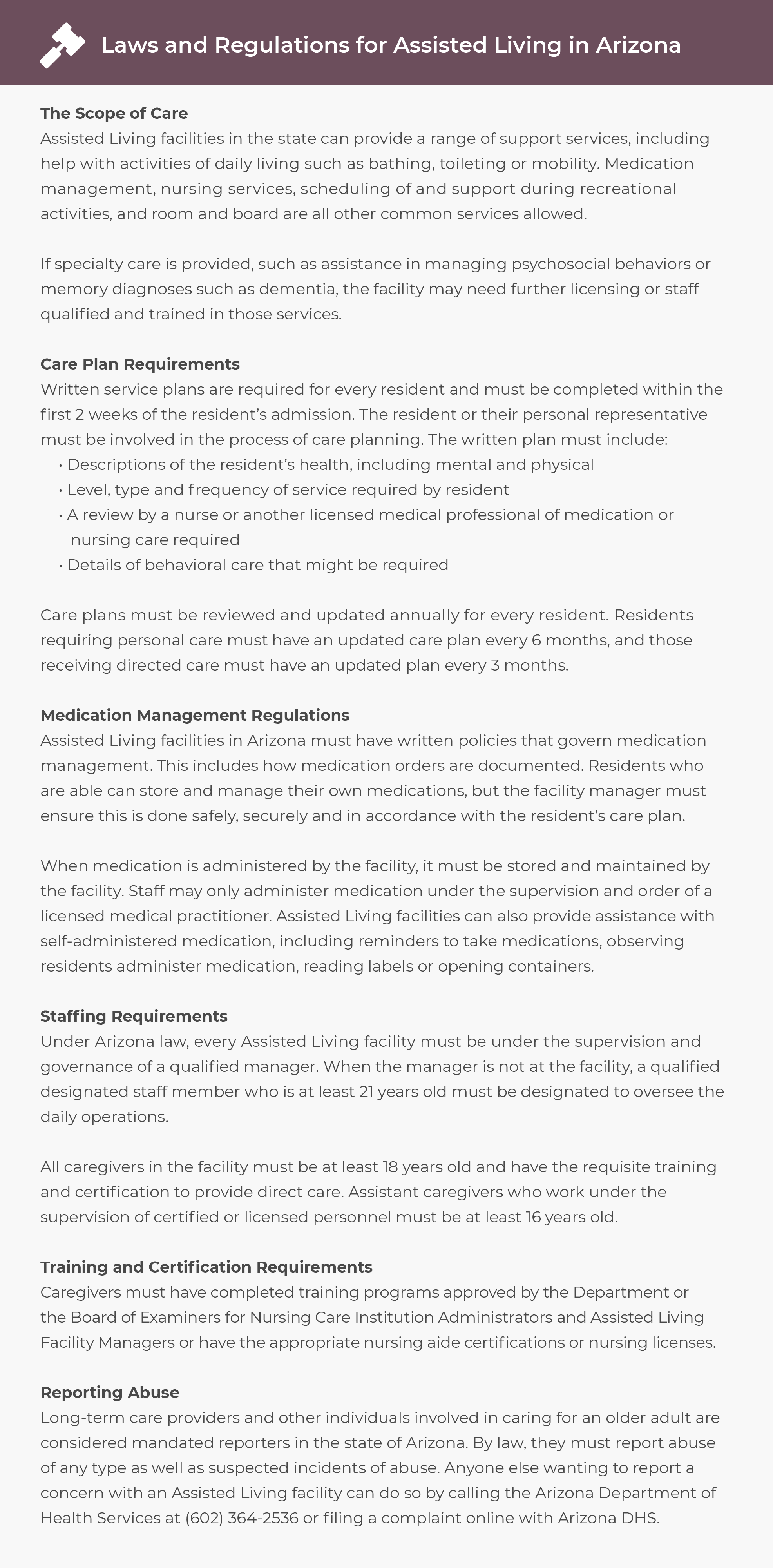The vibrant retirement community of Green Valley, Arizona, is home to over 21,000 residents. Known for its public golf courses and picturesque setting along the Santa Cruz River, Green Valley’s location in the Sonoran Desert also makes it a popular mild winter retreat. The town has a substantial senior population, and 79.3% of its inhabitants are aged 65 and older. Temperatures average between 40°F to 99°F, which allows residents to spend time outdoors year-round. Green Valley is home to many different types of attractions, including Desert Meadows Park, the Titan Missile Museum, Desert Meadows Park, the Green Valley Farmer’s Market, the Desert Diamonds Casino & Entertainment and the Historic Hacienda de la Canoa.
Senior citizens who do not require a clinical level of care but do need help with daily tasks and activities often decide to move into assisted living facilities. These facilities provide a residential setting with services and amenities designed for older adults. According to Genworth’s 2021 Cost of Care Survey, the average cost of assisted living in Green Valley is $4,050 per month. This is slightly higher than Arizona’s overall average but lower than the national average.
This guide provides an exploratory look at assisted living in Green Valley and includes cost comparisons and local resources.
Hundreds of thousands of American seniors utilize assisted living, a figure that is only growing. For these seniors, assisted living combines residential housing,assistance in daily activities, and some healthcare. These communities also strive to provide an atmosphere that is comfortable and engaging for their residents… Read More >
COVID-19 restrictions and rules for Assisted Living Facilities are typically set by the state – to see the rules in your state, you can read our guide to Assisted Living in Arizona. Keep in mind that there may be other policies that communities put in place to protect their residents, so you should contact your local community for more information. Additionally, you can contact your local Area Agency on Aging to learn more – find contact information here.
The average assisted living facility in Green Valley costs $4,050 per month.
Assisted living in Green Valley and other communities in the Tucson area are slightly higher than the Arizona average of $4,000 and $450 lower than the nationwide average of $4,500.
At an average of $4,050 per month, assisted living in Green Valley is slightly higher than in Arizona’s largest city, Phoenix, where residents of assisted living facilities pay an average of $3,975 per month. Costs are nearly $1,000 higher than in Green Valley at the northern Arizona community of Flagstaff, which averages $5,000. In Arizona’s southwestern corner, residents of Yuma pay slightly less than their Green Valley counterparts at $3,800 per month. Moving to the southeastern corner, Sierra Vista’s average costs are only $100 higher than they are in Green Valley.
Note: Data for Green Valley was unavailable, so data for the nearest city, Tucson, was used instead.

Since not everyone can afford to pay for assisted living out-of-pocket, it’s important to find alternative methods to help make assisted living more affordable. Some of these options include:
For more information about your options for making assisted living more affordable, visit our guide to Assisted Living in Arizona.
| Contact | Description | |
| Pima Council on Aging | 520) 790-0504 | The Pima Council on Aging provides valuable services and resources to help seniors live independently and age with dignity. Since 1967, the agency has advocated for seniors in the community, and its mission statement is focused on inclusion. Older adults in the Green Valley area can receive in-home care support, legal services, and financial planning. The families of seniors can participate in caregiver training. The Pima Council on Aging is funded by the City of Tucson, the Department of Economic Security, the Corporation for National & Community Service and the Administration for Community Living. |
| Arizona Department of Economic Security, Division of Aging and Adult Services | (602) 542-4446 | Health and Nutrition are the key focus areas of the DAAS, which provides older adults with nutritious meals and services to help manage chronic diseases. A six-week course is offered for seniors who are experiencing ongoing health problems. The Chronic Disease Self-Management Program helps older adults deal with difficult emotions, improve their physical health, and access beneficial treatments. The DAAS also organizes the Commodity Senior Food Program (CFSP), designed to help low-income seniors access healthy meals each month. |
| Arizona Department of Veteran’s Services (ADVS) | 520) 207-4960 | Veterans of the armed services and their families can receive assistance with claiming benefits, obtaining medical care and administrative services. Additional support services include the military relief fund and the Native American benefit. The Aid and Attendance Benefit is available for Veterans who need financial help to cover assisted living costs. |
| Posada Life Community Services | (520) 625-2273 | Since 1995, Posada Life Community Service has helped to empower seniors in the Green Valley area. This nonprofit organization offers adult daycare, behavioral health services and outpatient therapy. The Casa Community Center provides a place for older adults to socialize, with concerts, games, workshops, and other interactive programming. The community center also offers a senior lunch program. |
| Green Valley Assistance Services Inc. (GVAS) | (520) 625-5966 | The GVAS provides comprehensive health and social services to seniors and their families in the Green Valley area and the surrounding area. Seniors are provided with emergency housing and utility assistance, transportation services and a registered nurse program that advocates for senior health and independent living. |
Assisted Living Facilities in the Green Valley area are required to follow a set of rules and regulations that are determined at the state level. For an overview of those rules and regulations, see the information below. For more specific information, talk with your local community or Area Agency on Aging.







